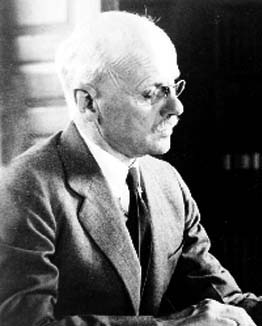


 تاريخ الرياضيات
تاريخ الرياضيات
 الرياضيات في الحضارات المختلفة
الرياضيات في الحضارات المختلفة 
 الرياضيات المتقطعة
الرياضيات المتقطعة
 الجبر
الجبر
 الهندسة
الهندسة 
 المعادلات التفاضلية و التكاملية
المعادلات التفاضلية و التكاملية 
 التحليل
التحليل
 علماء الرياضيات
علماء الرياضيات |
Read More
Date: 15-4-2017
Date: 15-4-2017
Date: 19-4-2017
|
Died: 5 March 1954 in Cambridge, Massachusetts, USA

Julian Coolidge's father, John Randolph Coolidge, was a lawyer. Julian's mother was Julia Gardner. Coolidge was educated at Harvard from where he received his B.A. degree summa cum laude in 1895. He then went to England to attend Balliol College, Oxford, and he graduated with a B.Sc. in 1897. It is interesting that this degree from Oxford was in natural science and it was the first natural science degree ever awarded by Oxford.
After studying at Oxford, Coolidge returned to the United States where he taught at Groton school in Connecticut from 1897 to 1899. Another interesting note is that one of the pupils that Coolidge taught at this school was Franklin D Roosevelt and the two remained friends for life. In 1899 Coolidge was appointed as an instructor at Harvard and, three years later, he became an assistant professor there. In 1902 he married Theresa Reynolds and they had two sons and five daughters.
Granted two years leave of absence from 1902 to study in Europe, he went to Turin where he studied under Corrado Segre and then to Bonn where he studied under Eduard Study. His doctoral dissertation was supervised by Study and, in 1904, he was awarded his doctorate by Bonn University for a thesis entitled Die dual-projektive Geometrie im elliptischen und sphärischen Raume (Dual-projective geometry in elliptical and spherical spaces).
After spending two years in Europe, Coolidge returned to Harvard where he taught for most of his career (the exception being 1927 when he returned to the Sorbonne in Paris as an exchange professor). He was promoted to associate professor in 1908. During World War I he served as a major in the US Army and, at the end of the war in 1918, he was promoted to full professor at Harvard. He was liaison officer to the French General Staff in Paris, where he had 2000 American men under his command, from 1918 to 1919. Coolidge organised courses for his men at the Sorbonne in 1919 and in that year the French government made him a chevalier of the Légion d'Honneur. In 1927 Coolidge was appointed as chairman of the Mathematics Department at Harvard. Two years later he became master of Lowell House where he lived until he retired in 1940. In 1936 he returned to Paris to receive further honours from the French Government.
Coolidge wrote many good texts on geometry including The Elements of Non-Euclidean Geometry (1909), A Treatise on the Circle and the Sphere (1916), The Geometry of the Complex Domain (1924) and A Treatise on Algebraic Plane Curves (1931). He also wrote on probability with An Introduction to Mathematical Probability (1925). After he retired his interests turned to the history of mathematics and he published works such as A History of Geometrical Methods (1940), A History of the Conic Sections and Quadric Surfaces (1945), and The Mathematics of Great Amateurs (1949).
We shall say a little about some of these works. The first four books listed above on geometry follow the style of Eduard Study and Corrado Segre but contain many original ideas due to Coolidge himself. An Introduction to Mathematical Probability is [4]:-
... one of the subject's first treatments in English and one of Coolidge's best known works ... it defined probability ... in terms of frequency, thereby making the subject amenable to mathematical applications in the sciences generally.
A History of Geometrical Methods was inspired by Chasles' classical Aperçu historique sur l'origine et le développement des méthodes en géométrie of 1837. In Coolidge's own words in the preface it was:-
... a new book dealing with the history of the methods which men have employed in dealing with geometrical questions.
The book is in three parts: synthetic geometry, algebraic geometry, and differential geometry. Struik reviewed the work and wrote:-
This is the book to be consulted by everyone who wants to know what we might call modern classical geometry and its history. It is not only a summary or description of results, but a systematic development of the material with proofs and corollaries, a kind of multiform textbook, from which the student cannot only get an orientation, but which he can use as a basis for his studies. A great number of special topics are briefly or amply discussed, from the geometry of the spider's web to modern criticism of enumerative geometry, Douglas' work on the Plateau problem, quaternions and some tensor analysis. Anecdotes and personal remarks enliven the argumentation.
In The Mathematics of Great Amateurs Coolidge writes in the preface that he looks at the mathematical work of:-
... sixteen men who were principally known for some other activity, yet whose success in the field of mathematics enabled them to make contributions of permanent value.
It will not surprise anyone who has read any of Coolidge's books that he was [1]:-
... an enthusiastic teacher with a flair for witty remarks.
Outside the field of mathematics his interests were running, swimming, rowing, and sailing [3]:-
He had a unique and loyal personality and had a good sense of humour. He was a robust and enthusiastic oarsman, and in the Torpids had the pleasure of helping to make 12 bumps for the college [Balliol] in two successive years.
Coolidge served both the Mathematical Association of America and the American Mathematical Society as vice-president, the first in 1924 and the second in 1918.
Articles:



|
|
|
|
دراسة يابانية لتقليل مخاطر أمراض المواليد منخفضي الوزن
|
|
|
|
|
|
|
اكتشاف أكبر مرجان في العالم قبالة سواحل جزر سليمان
|
|
|
|
|
|
|
المجمع العلمي ينظّم ندوة حوارية حول مفهوم العولمة الرقمية في بابل
|
|
|